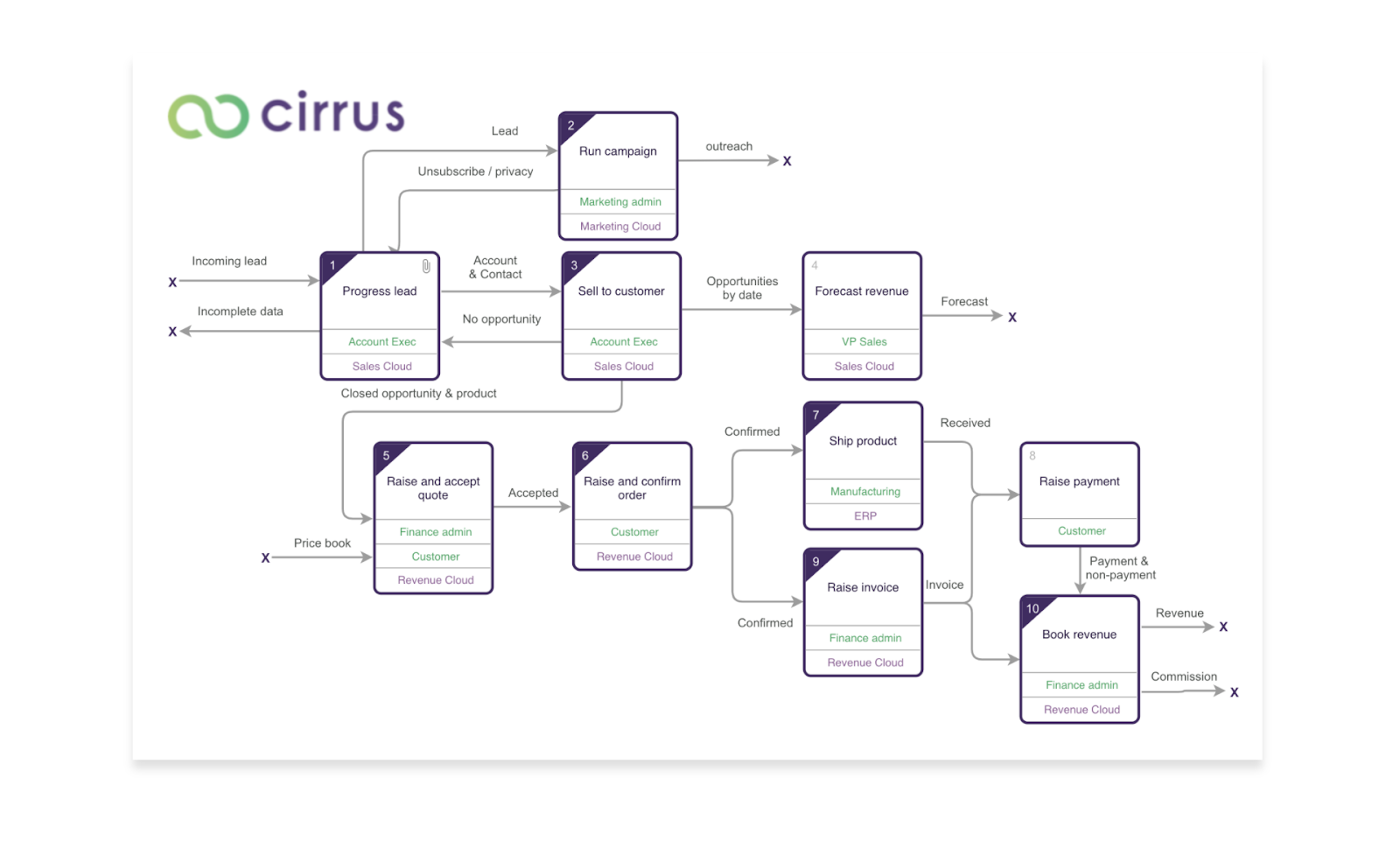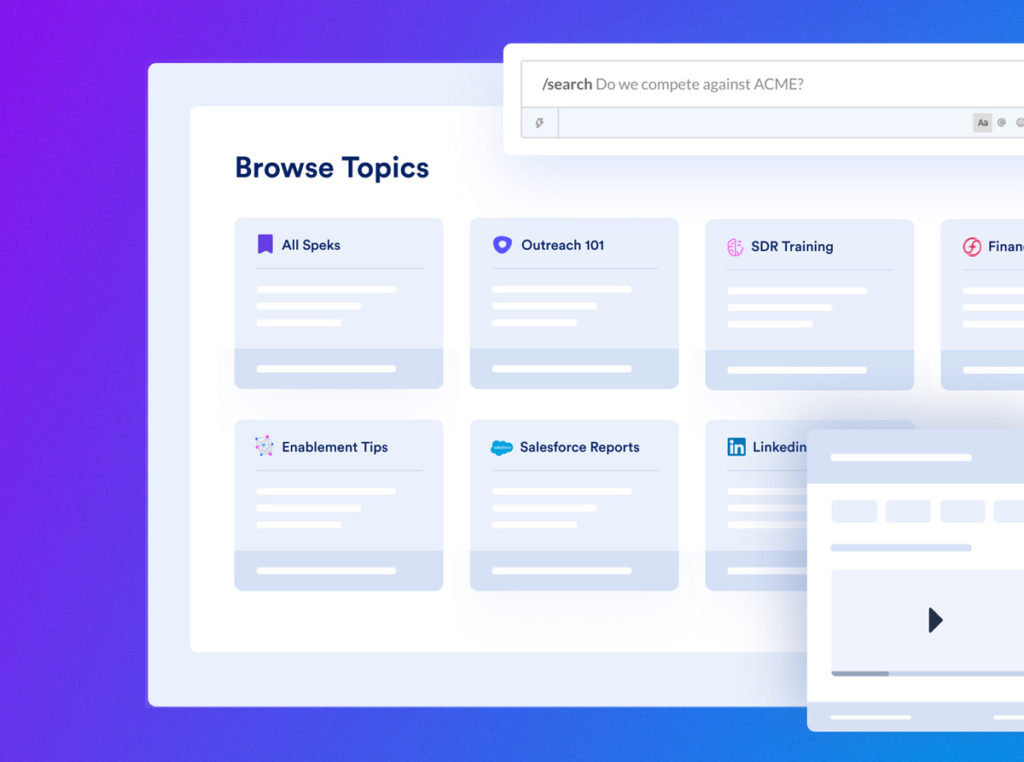Businesses globally are leveraging Salesforce to accelerate digital transformation in an ever-changing reality. Configuration and development, alone, is not sufficient to improve a Salesforce environment, and protect its integrity.
Insight before, during, and after any Salesforce configuration changes is crucial to avoid costly rework due to mistakes, to ‘do things right, first time’. Despite Salesforce orgs becoming increasingly complex, the Salesforce platform comes short at delivering the full visibility required – not that this is a negative point! Salesforce has succeeded in building a strong partner ecosystem that plug these gaps, and extend Salesforce capabilities.
Sonar, Elements.cloud, Spekit – three third-party platforms that support Salesforce org management in ‘change intelligence’, ‘configuration knowledge’, and ‘contextual training’.
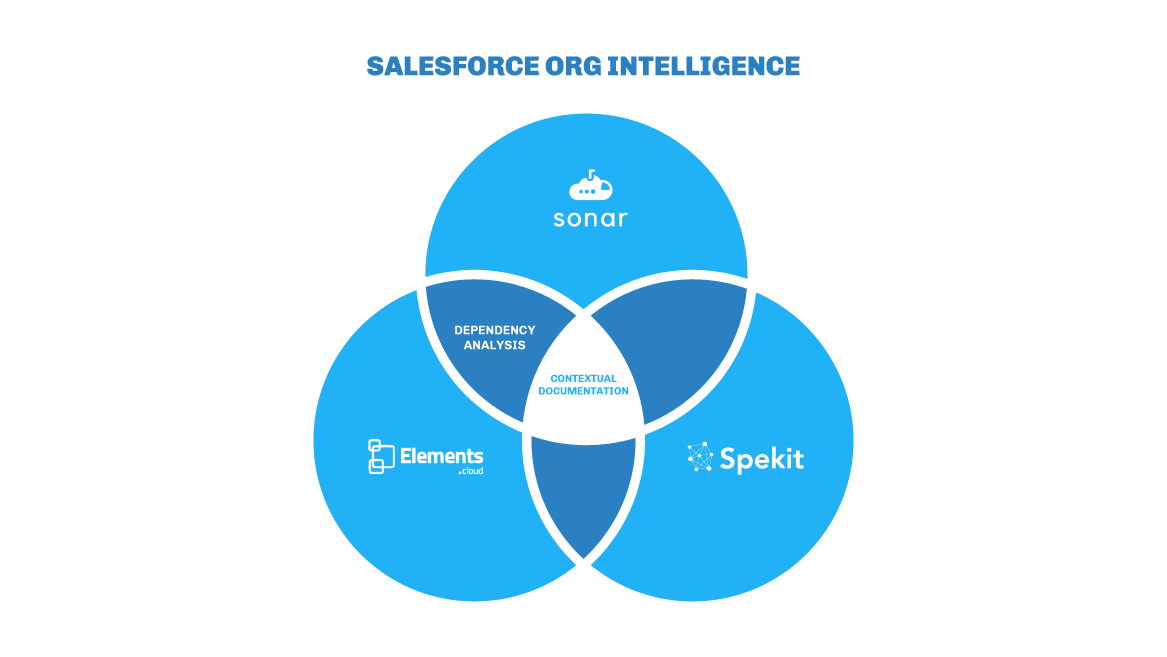

These vendors appear to have disparate offerings at first glance. So, what do they have in common? There are two commonalities.
- 1 – Recent funding
Firstly, they all received significant funding within 3 months of each other (in fact, two made the announcement on the same day, bar a $200k difference). The combined investment activity around these organizations is proof of the increasingly business-critical status Salesforce holds for many organizations; the stakes are too high when it comes to configuration changes and rolling these out to end-users.
- 2 – Platform offering
Secondly, there is some overlap in their offerings. These vendors could be arranged in a venn diagram, overlapping in two places: ‘dependency analysis’, and ‘contextual documentation’. This is exactly why I chose the term “Salesforce Org Intelligence”, an umbrella term that’s all-encompassing.
- Dependency analysis: identifying how fields and metadata are linked between one another (not only limited to the Salesforce platform, but also with integrated applications). This analysis helps you answer: ‘if I make a change here, what impact will it have there’.
- Contextual documentation: call upon guidance where, and when, you need guidance. That’s whether you are a Business Analyst, Salesforce Admin, Consultant (or an end-user never touching Salesforce setup)
The question is: why the rush towards Org Intelligence platforms?
To help answer this question, we will take a look into each organization, and its objectives.
Sonar
- Category (self-described): Change Intelligence
- Funding: $12m, Series A, 30 Mar 2021 (Press release, Crunchbase profile)
- Target persona: Sales Ops, RevOps, Marketing Ops.
Sonar is the ‘new kid’ on the block, founded in October 2018. Their “Change Intelligence platform” is best described using the submarine analogy that characterizes their brand:
“Sonar helps teams who feel underwater and in the dark get signals and navigate around hard-to-see problems in their tech stack integrations. Using the power of Change Intelligence, Sonar provides complete situational awareness of the impacts and dependencies that are necessary to confidently manage change.”
In tech-talk, this means identifying and visualizing the fields, metadata, and dependencies between platforms in your tech stack – ‘if I make a change here, what impact will it have there’.
It all started when Sonar CEO and Co-Founder Brad Smith made one big mistake at his previous company.
“While Brad was managing a complex tech stack — Salesforce, Marketo, HubSpot, and more — he accidentally wiped out an entire year’s worth of documented revenue with the click of a button. The mishap took the company offline for two days, cost the company over $100K, and kept deals from closing.”
While the founders’ story is enough to make anyone cringe, they’re able to see the lighter side, thanks to hindsight.
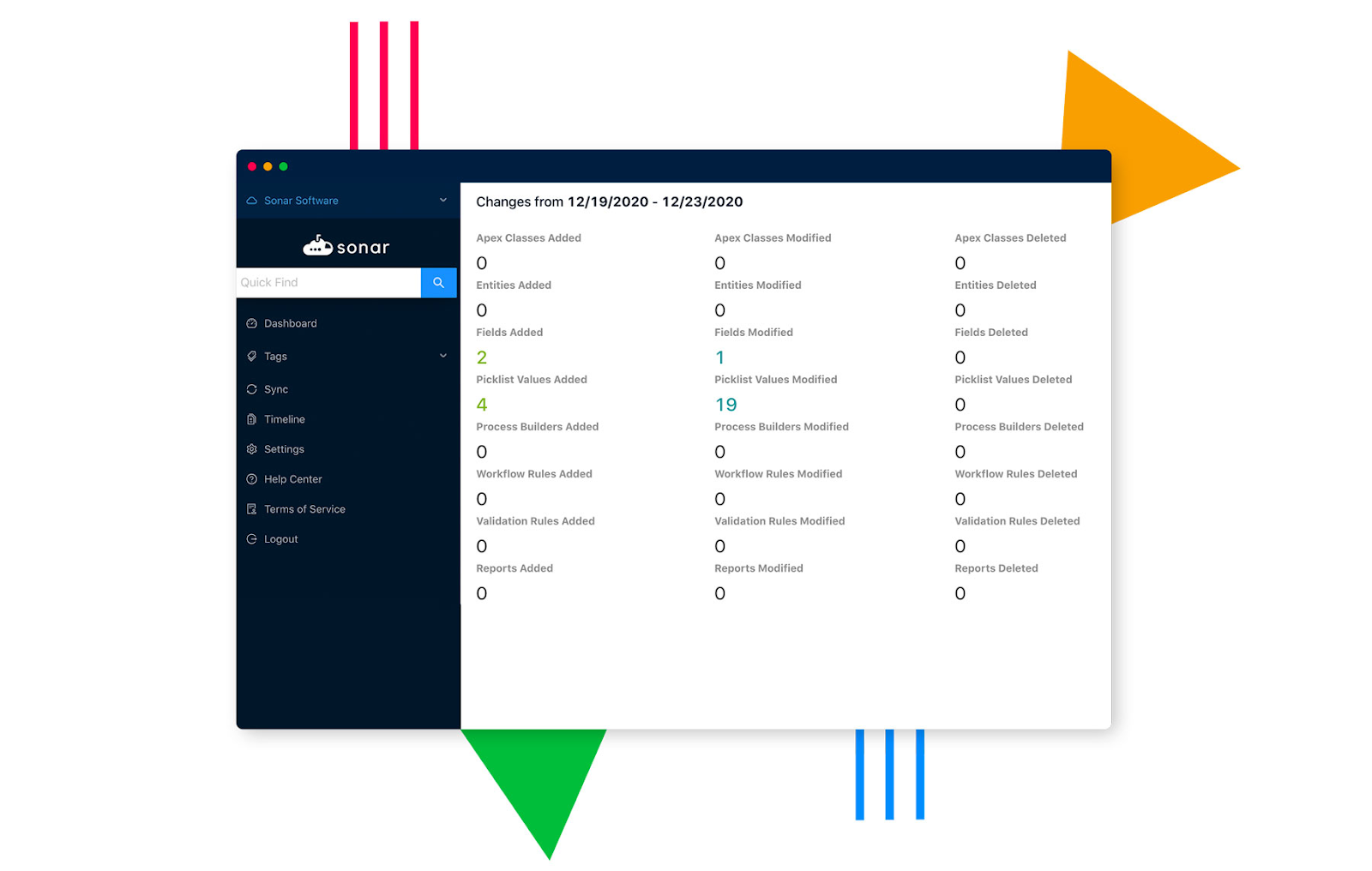

Sonar aims to appeal to operations professionals who oversee tools that extend beyond the Salesforce platform. Therefore, Sonar is platform-agnostic (not tied natively to Salesforce), giving you the flexibility to generate documentation that shows how other systems share data with Salesforce. Sonar automatically updates your documentation and alerts you to issues and changes, making collaboration across your team effortless through having access to everything in a single, shared platform.
Why focus on sales/revenue operations professionals? Sonar leads with the ethos that it’s not only about the technical aspects of the tools operations teams oversee, but it’s about the people and processes they support. That’s why they are laser-focused on appealing to those who are thinking strategically across their go-to-market teams. They also emphasise their intuitive user interface as a differentiator.
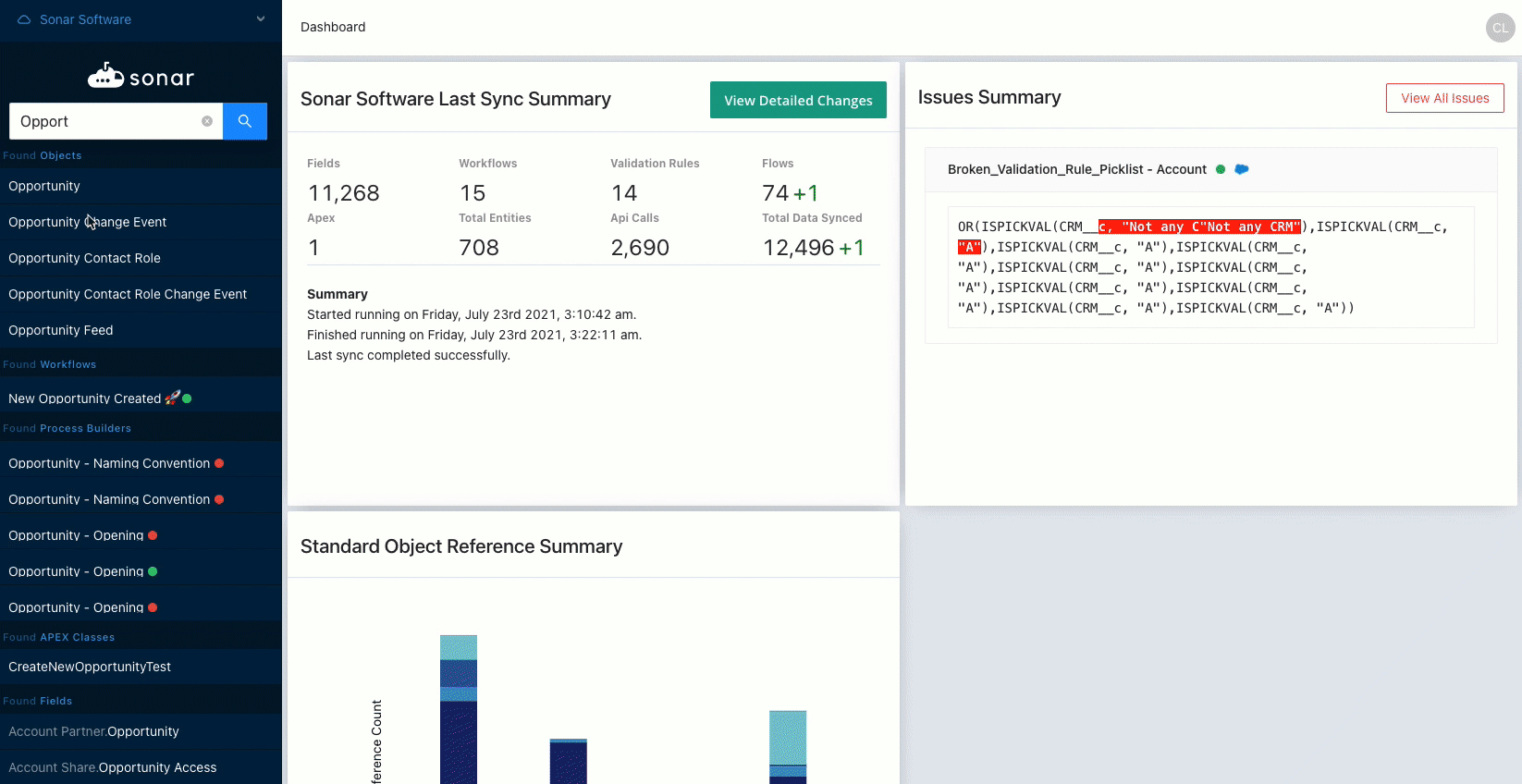

Elements
- Category (self-described): Configuration knowledge platform
- Funding: $20m, Jul 2021 (Press release, Crunchbase profile)
- Target persona: Business Analysts, Salesforce Consultants, Salesforce Developers, Salesforce Architects.
Elements is a “configuration knowledge platform”. What does that actually mean?
“Configuration knowledge pulls together all the documentation and analysis for Salesforce configuration so it can be seen, in context, with visibility on the interconnections” – Ian Gotts, Elements Founder
How Elements supports Salesforce orgs can be split into two main parts. Firstly, the analysis of a Salesforce org (incl. AppExchange packages), dependency analysis, and the impact changes could have on your org (aka. org impact).
Their second focus is documentation. Their ethos is that Salesforce org documentation must be contextual and related to the configuration itself, otherwise, insight into dependencies is lost. Disconnect the Salesforce org from its documentation, and knowledge becomes dispersed, siloed, and difficult to access, as a result.
The documentation we’re referring to here includes requirements, process maps, ERD, user stories, end-user help documentation, and more.
A ‘connected picture’ of documentation is their forte, outlining the ‘nuts and bolts’ of a Salesforce org. It’s due to this that they have struck a chord with their target audience (Business Analysts, Salesforce Consultants/Developers/Architects, Product Owners).
They’re especially appealing to platform owners, Center of Excellence leaders, who wish to drive a better ROI from Salesforce – or to consultancy teams who need to run audits on their clients’ orgs, in order to de-risk and accelerate projects.
From the backend documentation, whoever is responsible for the Salesforce org (be that a person, or a team) can surface guidance to Salesforce end-users, contextual to where they are interacting with the platform.
Spekit
- Category (self-described): Digital Enablement, “in-app digital companion”
- Funding: $12.2m, 30 Mar 2021 (Press release, Crunchbase profile)
- Target persona: Salesforce Admins, end-users.
Surfacing guidance to Salesforce end-users is more important than ever. The funding announcement leads with Spekit’s aim to “revolutionize the way employees work and learn in the remote age”.
What makes this possible? Designed around the employee experience, Spekit aims to be a user’s companion, with an emphasis on guidance for sales enablement (particularly valuable for new employee onboarding).
Spekit began as a data dictionary that remains core to their platform, allowing you to automatically map and document all fields in your Salesforce org.
The platform was founded by former Salesforce Admins and trainers, including Melanie Fellay, who was in charge of a Salesforce roll-out and had created a 50-page spreadsheet to track all fields and corresponding definitions. She knew there had to be a better, more automated way – and the idea for Spekit was born (read Melanie’s story: How We Reversed a Failed Salesforce Implementation).
In short – Spekit takes what the Salesforce Admin, product owner, etc. has documented, and puts it in front of Salesforce users.
Spekit materialises as a collapsible bar that users can call upon where, and when, they need guidance. For example, if I’m going to convert a Salesforce lead to an opportunity for the first time, would I dig through a document to figure out how to do it? That’s the beauty of digital adoption – embedded step-by-step instructions, readily available with only a quick mouse hover.
Spekit’s pièce de résistance lies in its ability to create a source of truth around end-user facing knowledge, both inside and outside of Salesforce (and applied to tools beyond Salesforce, for example, LinkedIn).
Even if the teams behind your Salesforce org aren’t hot on user documentation, Spekit comes pre-populated with all of the Salesforce Lightning “How do I” FAQs, so that the focus can be returned to documenting the questions that are key to your org.
Spekit may appear discordant in this line-up. Why Spekit is included here, in this article about ‘Org Intelligence’, is a good way to round up. Spekit supports change management, as does Sonar and Elements, however, Spekit’s focus shifts towards the employee experience (Salesforce end-users) versus the Admin/ops-only experience. Spekit allows Admins to answer questions such as: How do employees want to learn? How do they want to consume information? What are the key drivers that lead to better adoption of processes and the retention of information?
“No matter where your team lives (yup, we work outside of Salesforce too), this simple, automated training follows them to provide guidance and in-app learning anywhere they work – including being able to search for knowledge and training in Slack!” Melanie Fellay, How We Reversed a Failed Salesforce Implementation
Other Ecosystem Players – DevOps & AppOps
The ‘Salesforce Org Intelligence’ space is malleable, open to interpretation. The vendors featured thus far appeal to the personas that act as ‘translators’ between commercial stakeholders, and the technology – typically Business Analysts, Sales Ops, Salesforce Admins. They exist to ensure that any changes to your Salesforce org doesn’t wreck it, nor negatively impact user adoption.
Then we could find ourselves edging into DevOps and ‘AppOps’ territory, with deployment tools such as Gearset, Copado, Panaya and Prodly – a fraction of the landscape. This is another Salesforce app space that’s continually gaining traction because Salesforce customers and investors alike see the impending demand. All these providers – whether Org Intelligence, DevOps, AppOps – are successful due to the fact they protect org integrity throughout Salesforce configuration changes, and avoid costly rework due to mistakes, or bugs. Business continuity has a value that’s too high to sacrifice.
Final Thought
The idea for this article came about when three subsequent funding rounds were announced. I couldn’t help but see the pattern, and the overlapping objectives between each (even if, at first glance, they appear to have disparate offerings). Sonar, Elements, and Spekit are all working towards a similar goal of protecting Salesforce orgs from rogue changes.
Granted, “Org Intelligence” isn’t the only space receiving attention (another article, for another time). However, I see the platforms in this space becoming de facto, indispensable for Salesforce customers.
Do you agree?
Here’s a summary table of the vendors mentioned in this article:
| Categories | Funding | Target personas | |
|---|---|---|---|
| Elements | Configuration Knowledge Platform | $20m July 2021 | Business Analysts, Consultants |
| Sonar | Change Intelligence Platform | $12m 30 Mar 2021 | Sales Ops/RevOps |
| Spekit | “onboarding, training, documentation and data dictionary." | $12.2m March 30, 2021 | Admins, Consultants |


